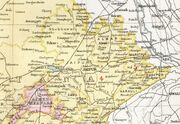
Flag of Kingdom of Jaipur 1128 AD/CE to 1949 AD/CE
Capital: Jaipur

Continent: Asia
Official Languages: Dhundari, Hindi
Established: 1128 AD/CE
Disestablished: 1949 AD/CE
History:
Jaipur's predecessor state was the kingdom of Dhundhar or Dausa, founded in 1093 by Dullah Rai, also known as Dulha Rao. The state was known as Amber between the fourteenth century and 1727. In that year, a new capital was built and named Jayapura, when the kingdom was renamed as Jaipur.
The Kachwahas claim descent from Kusha, son of the legendary Rama. Their ancestors allegedly migrated from Rama's kingdom of Kosala and established a new dynasty at Gwalior. After 31 generations, they moved to Rajputana and created a kingdom at Dhundhar. Dullah Rai, one of the ancestors of the Kachwaha rulers, defeated the Meenas of Manchi and Amber and later completed the conquest of Dhundhar by defeating the Bargurjars of Dausa and Deoti.
The rulers of Amber fought as generals in the army of Prithviraj Chauhan and later under the banner of Rana Sanga against the Mughals under Babur. The small kingdom of Amber was later conquered by Maldev Rathore and became feudatories of Marwar until the 16th century, Bharmal Kachwaha, sought alliance with Akbar to gain his political and military support against the Rathores of Marwar and his own divided clansmen. He was formally recognised as a Raja by the Mughals and was invested into the Mughal nobility in return for his daughter's marriage to Emperor Akbar. Raja Bharmal's daughter, Mariam-uz-Zamani, who married Akbar, later became the mother of the fourth Mughal emperor Jahangir. She gained prestige in the Mughal court both during the reign of her husband and that of her son as Empress and Queen mother respectively. By this relation, the Rajas of Amer also gained significant prominence in the Mughal court.
A governor was appointed to oversee Bharmal's territory and a tribute arrangement saw Bharmal given a salaried rank, paid for from a share of the area's revenue.
The ruling dynasty of Amber prospered under Mughal rule and provided the Mughal Empire with some distinguished generals. Among them were Bhagwant Das, Man Singh I, who fought and governed from Kabul to Orissa and Assam and Jai Singh I.
Jai Singh I was succeeded by Ram Singh I, Bishan Singh and Jai Singh II. Jai Singh II, also known as Sawai Jai Singh, ruled the state from 1699 to 1743 and was a famous mathematician and astronomer. During his rule, the new capital city of Jaipur was founded. in 1727.
Throughout the disintegration of the Mughal Empire, the armies of Jaipur were in a constant state of warfare. Towards the end of the 18th century, the Jats of Bharatpur and the Kachwaha chief of Alwar declared themselves independent from Jaipur and each annexed the eastern portion of Jaipur's territory. This period of Jaipur's history is characterised by internal power-struggles and constant military conflicts with the Marathas, Jats, other Rajput states, as well as the British and the Pindaris. Jaipur suffered against the Rathors of Marwar in the Battle of Gangwana with appalling losses. The kingdom again suffered a disastrous defeat at the hands of the Maratha forces of Mahadji Scindia in the Battle of Patan in 1790, forcing the rulers of Jaipur to pay heavy tributes. Nevertheless, enough wealth remained in Jaipur for the patronage of fine temples/palaces, continuity of its courtly traditions and the well-being of its citizens and merchant communities. Jaipurs last attempt to gain freedom from Gwalior ended in a defeat at the Battle of Malpura. A treaty was initially made by Maharaja Sawai Jagat Singh and the British under Governor General Marquis Wellesley in 1803, however the treaty was dissolved shortly afterwards by Wellesley's successor, Lord Cornwallis. In this event, Jaipur's Ambassador to Lord Lake observed that "This was the first time, since the English government was established in India, that it had been known to make its faith subservient to its convenience".
In 1818 Jaipur became a British protectorate by entering into a subsidiary alliance. In 1835 there was a serious disturbance in the city because of a false rumour that the British had murdered the infant raja to ensure the annexation, after which the British government intervened. The state later became well-governed and prosperous. During the Indian rebellion of 1857, when the British invoked the treaty to request assistance in the suppression of rebellious sepoys, the Maharaja opted to preserve his treaty, and thus sent in troops to help to subdue the uprisings in the area around Gurgaon.
Jaipur state had a revenue of Rs.65,00,000 in 1901, making it the wealthiest Princely state in Rajputana.
Jaipur's last princely ruler signed the accession to the Indian Union on 7 April 1949.
In 2019, titular Maharaja Padmanabh Singh (born 12 July 1998), full title Maharaja Sawai Padmanabh Singh of Jaipur, is the young monarch of Jaipur, a city in northwestern India famous for its pink architecture and imperial palaces. Estimates of the royal family's wealth vary, but Singh is estimated to control a fortune of between $697 million and $2.8 billion.
The Jaipur Residency was established in 1821. It included the states of Jaipur, Kishangarh and Lawa. The latter had belonged to the Haraoti-Tonk Agency until 1867.